Taxation and Business Accounting: Frank Lloyd Case Study Analysis
VerifiedAdded on 2023/06/08
|12
|2847
|229
Case Study
AI Summary
This assignment provides a detailed analysis of taxation principles through a case study involving Frank Lloyd, an architect who started a business in 2016. It examines the implications of using either the cash or accrual method of accounting for his business in 2016/17 and 2017/18, referencing relevant case law to support the analysis. The assignment also addresses the rights of the Taxation Commissioner and the impact of electronic accounting software. Furthermore, it delves into the deductibility of various expenses incurred by Ruby Pty Ltd, including repair costs, legal expenses, compensation payments, and accounting provisions, under Section 8-1 of the ITAA 1997. The analysis considers both positive and negative limbs of the legislation, along with relevant court decisions, to determine whether these expenses can be claimed as deductions.
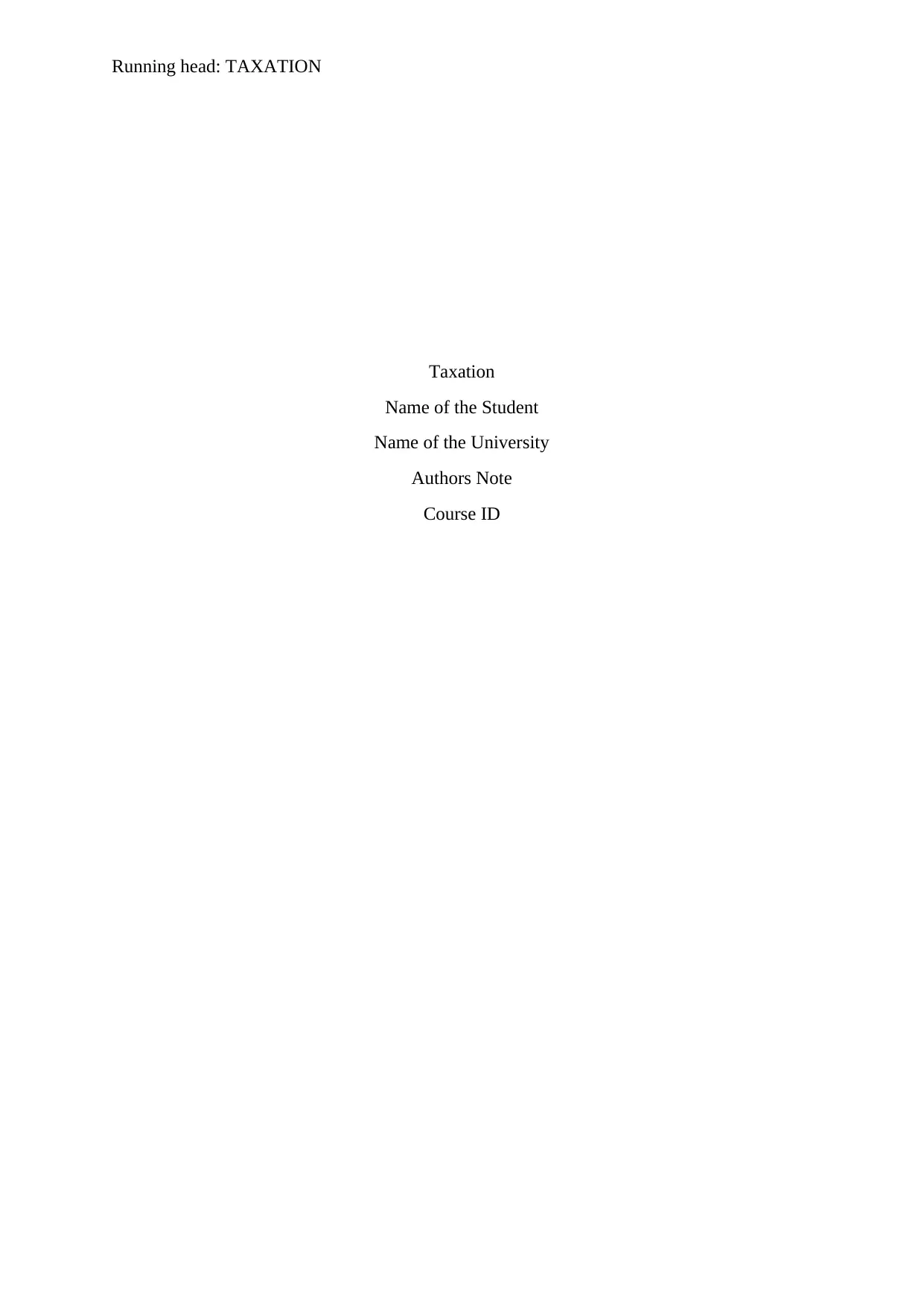
Running head: TAXATION
Taxation
Name of the Student
Name of the University
Authors Note
Course ID
Taxation
Name of the Student
Name of the University
Authors Note
Course ID
Paraphrase This Document
Need a fresh take? Get an instant paraphrase of this document with our AI Paraphraser
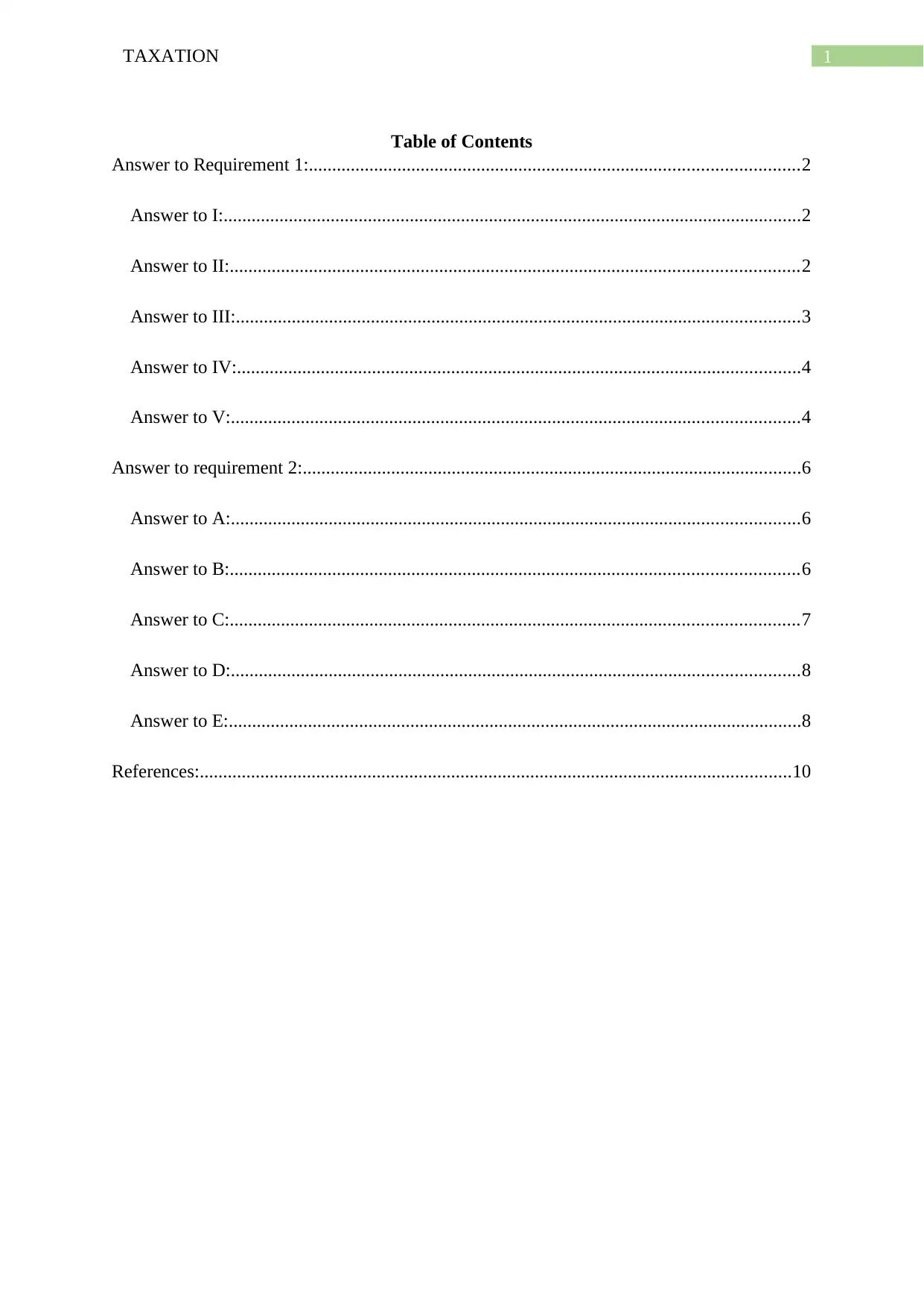
1TAXATION
Table of Contents
Answer to Requirement 1:.........................................................................................................2
Answer to I:............................................................................................................................2
Answer to II:..........................................................................................................................2
Answer to III:.........................................................................................................................3
Answer to IV:.........................................................................................................................4
Answer to V:..........................................................................................................................4
Answer to requirement 2:...........................................................................................................6
Answer to A:..........................................................................................................................6
Answer to B:..........................................................................................................................6
Answer to C:..........................................................................................................................7
Answer to D:..........................................................................................................................8
Answer to E:...........................................................................................................................8
References:...............................................................................................................................10
Table of Contents
Answer to Requirement 1:.........................................................................................................2
Answer to I:............................................................................................................................2
Answer to II:..........................................................................................................................2
Answer to III:.........................................................................................................................3
Answer to IV:.........................................................................................................................4
Answer to V:..........................................................................................................................4
Answer to requirement 2:...........................................................................................................6
Answer to A:..........................................................................................................................6
Answer to B:..........................................................................................................................6
Answer to C:..........................................................................................................................7
Answer to D:..........................................................................................................................8
Answer to E:...........................................................................................................................8
References:...............................................................................................................................10

2TAXATION
Answer to Requirement 1:
Answer to I:
The difference between the cash basis and accrual method of accounting is dependent
upon the sales and purchase that is recorded the accounting books. Under the cash method of
accounting the revenues and the expenditure are identified based on the situations when there
is a change of hands (Bushman et al., 2016). While in accrual accounting method the
revenues are identified as and when it is earned. A taxpayer may use either cash or accrual
method of accounting depending upon the definite factors. The cash method is easy to
understand and maintain.
Under the cash method of accounting there is accrual allocation or computations. As
held in “Carden v FC of T (1938)” majority of the business functions is completely carried
out based on the cash method as business might sell the products for which payments are
received later or any other types of transactions that arises and payment which is received in
later instances (Nallareddy et al., 2017). The court in “Henderson v FC of T (1970)” held
that under the accrual method of accounting a business is provided with the better situations
regarding the expenses and income that arises from the profitability. Factors namely the
double entry bookkeeping might be held as the valuable in deciding regarding the method of
business to understand the information relating to the bookkeeping equation. Factors such as
cash flow is regarded as the best element in understanding the method of accounting that
provides the business with the better scenario of the cash flow.
Factors affecting the choice of cash or accrual basis of accounting:
Certain factors affecting the choice of accrual or cash basis of accounting is given below
a. Business size
b. Complexity of business
Answer to Requirement 1:
Answer to I:
The difference between the cash basis and accrual method of accounting is dependent
upon the sales and purchase that is recorded the accounting books. Under the cash method of
accounting the revenues and the expenditure are identified based on the situations when there
is a change of hands (Bushman et al., 2016). While in accrual accounting method the
revenues are identified as and when it is earned. A taxpayer may use either cash or accrual
method of accounting depending upon the definite factors. The cash method is easy to
understand and maintain.
Under the cash method of accounting there is accrual allocation or computations. As
held in “Carden v FC of T (1938)” majority of the business functions is completely carried
out based on the cash method as business might sell the products for which payments are
received later or any other types of transactions that arises and payment which is received in
later instances (Nallareddy et al., 2017). The court in “Henderson v FC of T (1970)” held
that under the accrual method of accounting a business is provided with the better situations
regarding the expenses and income that arises from the profitability. Factors namely the
double entry bookkeeping might be held as the valuable in deciding regarding the method of
business to understand the information relating to the bookkeeping equation. Factors such as
cash flow is regarded as the best element in understanding the method of accounting that
provides the business with the better scenario of the cash flow.
Factors affecting the choice of cash or accrual basis of accounting:
Certain factors affecting the choice of accrual or cash basis of accounting is given below
a. Business size
b. Complexity of business
⊘ This is a preview!⊘
Do you want full access?
Subscribe today to unlock all pages.

Trusted by 1+ million students worldwide
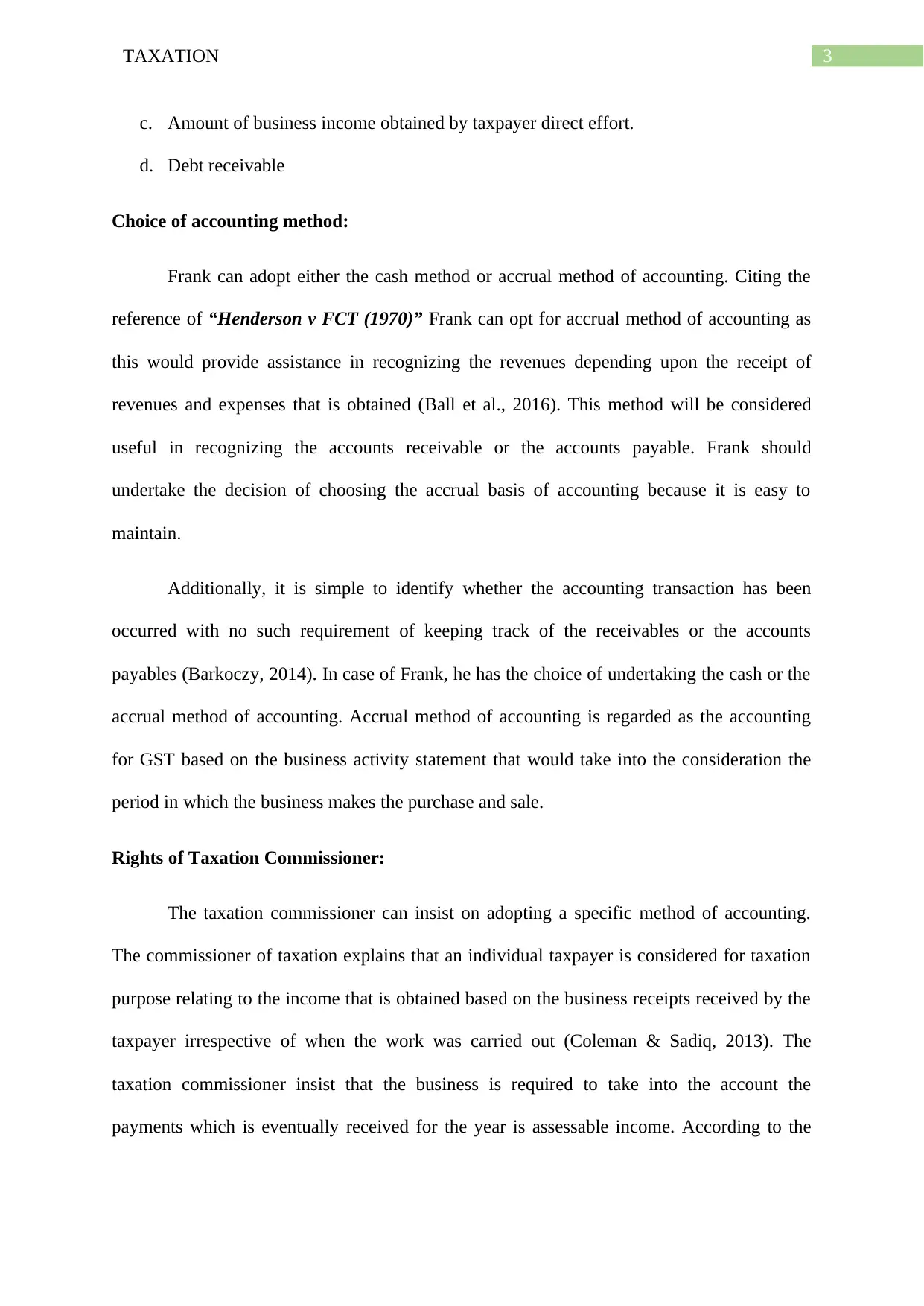
3TAXATION
c. Amount of business income obtained by taxpayer direct effort.
d. Debt receivable
Choice of accounting method:
Frank can adopt either the cash method or accrual method of accounting. Citing the
reference of “Henderson v FCT (1970)” Frank can opt for accrual method of accounting as
this would provide assistance in recognizing the revenues depending upon the receipt of
revenues and expenses that is obtained (Ball et al., 2016). This method will be considered
useful in recognizing the accounts receivable or the accounts payable. Frank should
undertake the decision of choosing the accrual basis of accounting because it is easy to
maintain.
Additionally, it is simple to identify whether the accounting transaction has been
occurred with no such requirement of keeping track of the receivables or the accounts
payables (Barkoczy, 2014). In case of Frank, he has the choice of undertaking the cash or the
accrual method of accounting. Accrual method of accounting is regarded as the accounting
for GST based on the business activity statement that would take into the consideration the
period in which the business makes the purchase and sale.
Rights of Taxation Commissioner:
The taxation commissioner can insist on adopting a specific method of accounting.
The commissioner of taxation explains that an individual taxpayer is considered for taxation
purpose relating to the income that is obtained based on the business receipts received by the
taxpayer irrespective of when the work was carried out (Coleman & Sadiq, 2013). The
taxation commissioner insist that the business is required to take into the account the
payments which is eventually received for the year is assessable income. According to the
c. Amount of business income obtained by taxpayer direct effort.
d. Debt receivable
Choice of accounting method:
Frank can adopt either the cash method or accrual method of accounting. Citing the
reference of “Henderson v FCT (1970)” Frank can opt for accrual method of accounting as
this would provide assistance in recognizing the revenues depending upon the receipt of
revenues and expenses that is obtained (Ball et al., 2016). This method will be considered
useful in recognizing the accounts receivable or the accounts payable. Frank should
undertake the decision of choosing the accrual basis of accounting because it is easy to
maintain.
Additionally, it is simple to identify whether the accounting transaction has been
occurred with no such requirement of keeping track of the receivables or the accounts
payables (Barkoczy, 2014). In case of Frank, he has the choice of undertaking the cash or the
accrual method of accounting. Accrual method of accounting is regarded as the accounting
for GST based on the business activity statement that would take into the consideration the
period in which the business makes the purchase and sale.
Rights of Taxation Commissioner:
The taxation commissioner can insist on adopting a specific method of accounting.
The commissioner of taxation explains that an individual taxpayer is considered for taxation
purpose relating to the income that is obtained based on the business receipts received by the
taxpayer irrespective of when the work was carried out (Coleman & Sadiq, 2013). The
taxation commissioner insist that the business is required to take into the account the
payments which is eventually received for the year is assessable income. According to the
Paraphrase This Document
Need a fresh take? Get an instant paraphrase of this document with our AI Paraphraser

4TAXATION
taxation commissioner a business that have the aggregate turnover of less than $10 million
can chose to account under cash method for GST purpose.
The court in “FC of T v Firstenberg (1976)” held that accounting for cash basis
constitute that the business must account for the GST in the business activity statement. It
should cover the accounting period where the business obtains or pays for purchase and sale
(Grange et al., 2014). The taxation commissioner insist that a business obtains the advantage
under the cash method since this method is useful for a business in supporting the alignment
of liabilities of business activity statement with easy management of cash flow.
Answer to IV:
The present case situation of Frank highlights that during the accounting year of
2016/17 Frank derived the revenue of $75,000 however in the following year of 2017/18 the
yearly sales turnover of the company amounted to $2.5 million. During the financial year of
both 2016/17 and 2017/18 the company’s annual turnover stood below the agreed limit of
$10 million. The court of law in “FC of T v Dunn (1989)” held that a business under the
cash basis of accounting is required to record transactions based on the cash basis given the
business exceeds prescribed annual turnover limit of lower than $2 and $10 million
correspondingly (James, 2014).
As understood in the current situation of Frank the accounting method would remain
the same for the accounting year of 2016/17 or 2017/18 as Franks business is primarily small
and less than the yearly turnover boundary of $10 million. Frank is required to account for
the input tax credit for creditable purpose but up to the extent that the company offers
considerations for the taxation period (Jover-Ledesma, 2014). The accounting method for
Frank for the year 2017 and 2018 would remain same as Frank is required to account under
the cash basis.
taxation commissioner a business that have the aggregate turnover of less than $10 million
can chose to account under cash method for GST purpose.
The court in “FC of T v Firstenberg (1976)” held that accounting for cash basis
constitute that the business must account for the GST in the business activity statement. It
should cover the accounting period where the business obtains or pays for purchase and sale
(Grange et al., 2014). The taxation commissioner insist that a business obtains the advantage
under the cash method since this method is useful for a business in supporting the alignment
of liabilities of business activity statement with easy management of cash flow.
Answer to IV:
The present case situation of Frank highlights that during the accounting year of
2016/17 Frank derived the revenue of $75,000 however in the following year of 2017/18 the
yearly sales turnover of the company amounted to $2.5 million. During the financial year of
both 2016/17 and 2017/18 the company’s annual turnover stood below the agreed limit of
$10 million. The court of law in “FC of T v Dunn (1989)” held that a business under the
cash basis of accounting is required to record transactions based on the cash basis given the
business exceeds prescribed annual turnover limit of lower than $2 and $10 million
correspondingly (James, 2014).
As understood in the current situation of Frank the accounting method would remain
the same for the accounting year of 2016/17 or 2017/18 as Franks business is primarily small
and less than the yearly turnover boundary of $10 million. Frank is required to account for
the input tax credit for creditable purpose but up to the extent that the company offers
considerations for the taxation period (Jover-Ledesma, 2014). The accounting method for
Frank for the year 2017 and 2018 would remain same as Frank is required to account under
the cash basis.
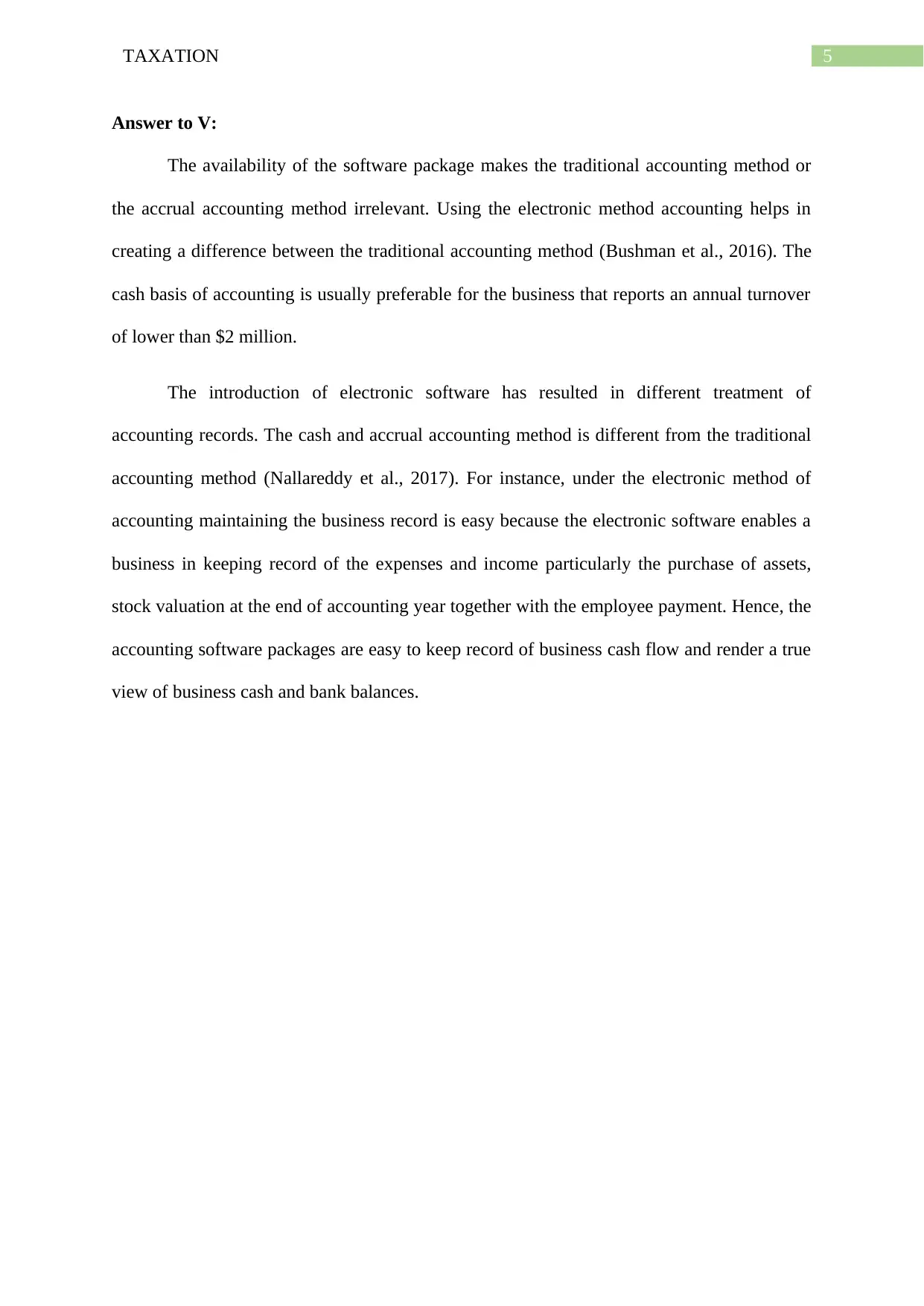
5TAXATION
Answer to V:
The availability of the software package makes the traditional accounting method or
the accrual accounting method irrelevant. Using the electronic method accounting helps in
creating a difference between the traditional accounting method (Bushman et al., 2016). The
cash basis of accounting is usually preferable for the business that reports an annual turnover
of lower than $2 million.
The introduction of electronic software has resulted in different treatment of
accounting records. The cash and accrual accounting method is different from the traditional
accounting method (Nallareddy et al., 2017). For instance, under the electronic method of
accounting maintaining the business record is easy because the electronic software enables a
business in keeping record of the expenses and income particularly the purchase of assets,
stock valuation at the end of accounting year together with the employee payment. Hence, the
accounting software packages are easy to keep record of business cash flow and render a true
view of business cash and bank balances.
Answer to V:
The availability of the software package makes the traditional accounting method or
the accrual accounting method irrelevant. Using the electronic method accounting helps in
creating a difference between the traditional accounting method (Bushman et al., 2016). The
cash basis of accounting is usually preferable for the business that reports an annual turnover
of lower than $2 million.
The introduction of electronic software has resulted in different treatment of
accounting records. The cash and accrual accounting method is different from the traditional
accounting method (Nallareddy et al., 2017). For instance, under the electronic method of
accounting maintaining the business record is easy because the electronic software enables a
business in keeping record of the expenses and income particularly the purchase of assets,
stock valuation at the end of accounting year together with the employee payment. Hence, the
accounting software packages are easy to keep record of business cash flow and render a true
view of business cash and bank balances.
⊘ This is a preview!⊘
Do you want full access?
Subscribe today to unlock all pages.

Trusted by 1+ million students worldwide

6TAXATION
Answer to requirement 2:
Answer to A:
The two positive limbs of “section 8-1 of the ITAA 1997” explain that a person can
deduct from their taxable income any expenditure or the losses up to the extent that the
expenses is occurred for obtaining the taxable income or it occurred in performing the
business with the objective of producing their taxable income (Ball et al., 2016). The
Australian Taxation Office explains that a person can claim deductions for certain
expenditure a taxpayer incurs when the property is rented out. As defined under “subsection
25-10 (1)” the term repair comprises of restoration of asset to the previous state without
changing the essential character or functions.
The court of law in “BP Oil Refinery Ltd v FC of T (1992)” held that the repair
consists of the renewal and replacement of the subsidiary part of a whole but does not
comprise of overall reconstruction. Ruby incurred cost on replacing the fittings of kitchen and
deteriorated cupboard which was destroyed in storm. With reference to “section 8-1 of the
ITAA 1997” Ruby would be allowed to claim a general deduction for the repairs expenses
(Barth et al., 2016). The costs of repairs represent restoration of the asset functions and
efficiency with no changes or improvement in character of the asset.
Answer to B:
Certain legal spending incurred in generating the rental income are considered for
deductions. This includes the expenses incurred in evicting the non-paying tenant, taking the
actions of court due to loss of rental income and taking defending the claims for damages
relating to injuries that is suffered by the third party on their rental property (Gordon et al.,
2017). As held in “Herald & Weekly Times v FCT (1991)” the court allowed the taxpayer
Answer to requirement 2:
Answer to A:
The two positive limbs of “section 8-1 of the ITAA 1997” explain that a person can
deduct from their taxable income any expenditure or the losses up to the extent that the
expenses is occurred for obtaining the taxable income or it occurred in performing the
business with the objective of producing their taxable income (Ball et al., 2016). The
Australian Taxation Office explains that a person can claim deductions for certain
expenditure a taxpayer incurs when the property is rented out. As defined under “subsection
25-10 (1)” the term repair comprises of restoration of asset to the previous state without
changing the essential character or functions.
The court of law in “BP Oil Refinery Ltd v FC of T (1992)” held that the repair
consists of the renewal and replacement of the subsidiary part of a whole but does not
comprise of overall reconstruction. Ruby incurred cost on replacing the fittings of kitchen and
deteriorated cupboard which was destroyed in storm. With reference to “section 8-1 of the
ITAA 1997” Ruby would be allowed to claim a general deduction for the repairs expenses
(Barth et al., 2016). The costs of repairs represent restoration of the asset functions and
efficiency with no changes or improvement in character of the asset.
Answer to B:
Certain legal spending incurred in generating the rental income are considered for
deductions. This includes the expenses incurred in evicting the non-paying tenant, taking the
actions of court due to loss of rental income and taking defending the claims for damages
relating to injuries that is suffered by the third party on their rental property (Gordon et al.,
2017). As held in “Herald & Weekly Times v FCT (1991)” the court allowed the taxpayer
Paraphrase This Document
Need a fresh take? Get an instant paraphrase of this document with our AI Paraphraser

7TAXATION
with deductions for the costs that are incurred as the consequence of taxpayer income
producing activities.
During the year Ruby incurred legal expenses of $7,000 since one of her tenants
skidded on the steps and sustained injuries. Therefore, legal expenditure $7,000 will be
allowed for deductions because the expenditure is incurred in defending the claims of the
injuries which is suffered by the tenant on rental property. The expenditure would be entitled
to deduction because since it arises from the letting of the property to the tenant with the
objective of claiming taxable income and can be appropriately held as having occurred in the
course of gaining or generating the taxable income (Kenny, 2013). The legal expenditure
possesses appropriate connection with the rental income with the expenses are becoming
incidental and relevant in the generation of the taxable rental income.
Answer to C:
As defined under the to “section 8-1 of the ITAA 1997” an individual taxpayer is
allowed to claim deductions from their assessable income relating to the expenses that is
incurred in gaining the assessable income (Krever, 2013). However, a taxpayer is denied
deductions for the expenses that are domestic, private or capital in nature or associated in the
derivation of the exempted income. The taxation commissioner in “Hallstroms Pty Ltd v
FCT (1946)” held that in determining whether the deductions for the legal expenditure is
allowed under the provision of section “section 8-1 of the ITAA 1997”, the character of the
expenses must be considered (Morgan et al., 2013). As understood in the present situation of
Ruby Pty Ltd because the company has occurred expenditure on paying the compensation
damage. The claim settlement amount stood $750,000 for the car manufacturing company.
Citing the reference of the court decision in “Sun Newspaper Ltd v FCT (1938)” it
was held that the expenses that is incurred by the taxpayer which is in the direction of
with deductions for the costs that are incurred as the consequence of taxpayer income
producing activities.
During the year Ruby incurred legal expenses of $7,000 since one of her tenants
skidded on the steps and sustained injuries. Therefore, legal expenditure $7,000 will be
allowed for deductions because the expenditure is incurred in defending the claims of the
injuries which is suffered by the tenant on rental property. The expenditure would be entitled
to deduction because since it arises from the letting of the property to the tenant with the
objective of claiming taxable income and can be appropriately held as having occurred in the
course of gaining or generating the taxable income (Kenny, 2013). The legal expenditure
possesses appropriate connection with the rental income with the expenses are becoming
incidental and relevant in the generation of the taxable rental income.
Answer to C:
As defined under the to “section 8-1 of the ITAA 1997” an individual taxpayer is
allowed to claim deductions from their assessable income relating to the expenses that is
incurred in gaining the assessable income (Krever, 2013). However, a taxpayer is denied
deductions for the expenses that are domestic, private or capital in nature or associated in the
derivation of the exempted income. The taxation commissioner in “Hallstroms Pty Ltd v
FCT (1946)” held that in determining whether the deductions for the legal expenditure is
allowed under the provision of section “section 8-1 of the ITAA 1997”, the character of the
expenses must be considered (Morgan et al., 2013). As understood in the present situation of
Ruby Pty Ltd because the company has occurred expenditure on paying the compensation
damage. The claim settlement amount stood $750,000 for the car manufacturing company.
Citing the reference of the court decision in “Sun Newspaper Ltd v FCT (1938)” it
was held that the expenses that is incurred by the taxpayer which is in the direction of
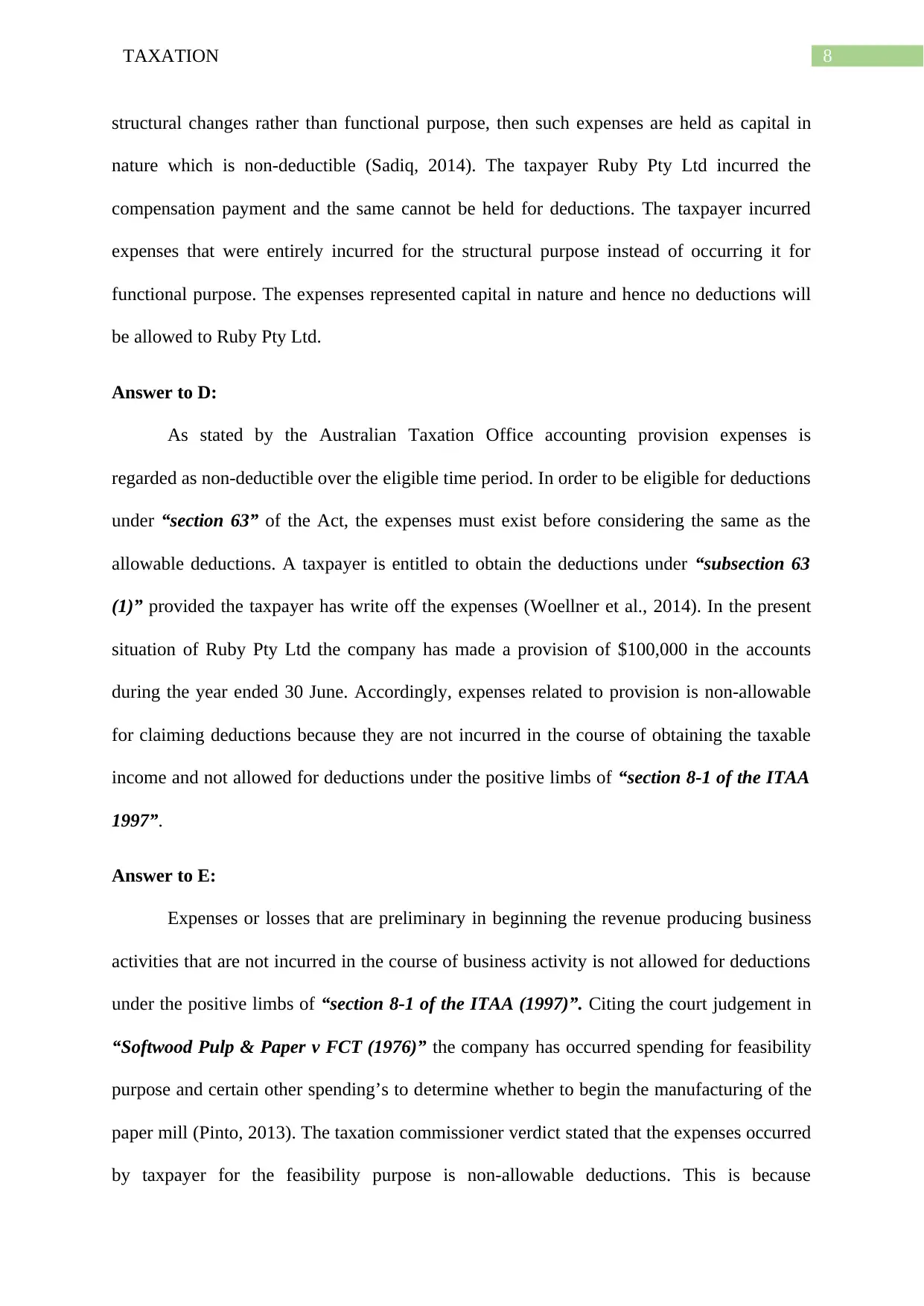
8TAXATION
structural changes rather than functional purpose, then such expenses are held as capital in
nature which is non-deductible (Sadiq, 2014). The taxpayer Ruby Pty Ltd incurred the
compensation payment and the same cannot be held for deductions. The taxpayer incurred
expenses that were entirely incurred for the structural purpose instead of occurring it for
functional purpose. The expenses represented capital in nature and hence no deductions will
be allowed to Ruby Pty Ltd.
Answer to D:
As stated by the Australian Taxation Office accounting provision expenses is
regarded as non-deductible over the eligible time period. In order to be eligible for deductions
under “section 63” of the Act, the expenses must exist before considering the same as the
allowable deductions. A taxpayer is entitled to obtain the deductions under “subsection 63
(1)” provided the taxpayer has write off the expenses (Woellner et al., 2014). In the present
situation of Ruby Pty Ltd the company has made a provision of $100,000 in the accounts
during the year ended 30 June. Accordingly, expenses related to provision is non-allowable
for claiming deductions because they are not incurred in the course of obtaining the taxable
income and not allowed for deductions under the positive limbs of “section 8-1 of the ITAA
1997”.
Answer to E:
Expenses or losses that are preliminary in beginning the revenue producing business
activities that are not incurred in the course of business activity is not allowed for deductions
under the positive limbs of “section 8-1 of the ITAA (1997)”. Citing the court judgement in
“Softwood Pulp & Paper v FCT (1976)” the company has occurred spending for feasibility
purpose and certain other spending’s to determine whether to begin the manufacturing of the
paper mill (Pinto, 2013). The taxation commissioner verdict stated that the expenses occurred
by taxpayer for the feasibility purpose is non-allowable deductions. This is because
structural changes rather than functional purpose, then such expenses are held as capital in
nature which is non-deductible (Sadiq, 2014). The taxpayer Ruby Pty Ltd incurred the
compensation payment and the same cannot be held for deductions. The taxpayer incurred
expenses that were entirely incurred for the structural purpose instead of occurring it for
functional purpose. The expenses represented capital in nature and hence no deductions will
be allowed to Ruby Pty Ltd.
Answer to D:
As stated by the Australian Taxation Office accounting provision expenses is
regarded as non-deductible over the eligible time period. In order to be eligible for deductions
under “section 63” of the Act, the expenses must exist before considering the same as the
allowable deductions. A taxpayer is entitled to obtain the deductions under “subsection 63
(1)” provided the taxpayer has write off the expenses (Woellner et al., 2014). In the present
situation of Ruby Pty Ltd the company has made a provision of $100,000 in the accounts
during the year ended 30 June. Accordingly, expenses related to provision is non-allowable
for claiming deductions because they are not incurred in the course of obtaining the taxable
income and not allowed for deductions under the positive limbs of “section 8-1 of the ITAA
1997”.
Answer to E:
Expenses or losses that are preliminary in beginning the revenue producing business
activities that are not incurred in the course of business activity is not allowed for deductions
under the positive limbs of “section 8-1 of the ITAA (1997)”. Citing the court judgement in
“Softwood Pulp & Paper v FCT (1976)” the company has occurred spending for feasibility
purpose and certain other spending’s to determine whether to begin the manufacturing of the
paper mill (Pinto, 2013). The taxation commissioner verdict stated that the expenses occurred
by taxpayer for the feasibility purpose is non-allowable deductions. This is because
⊘ This is a preview!⊘
Do you want full access?
Subscribe today to unlock all pages.

Trusted by 1+ million students worldwide
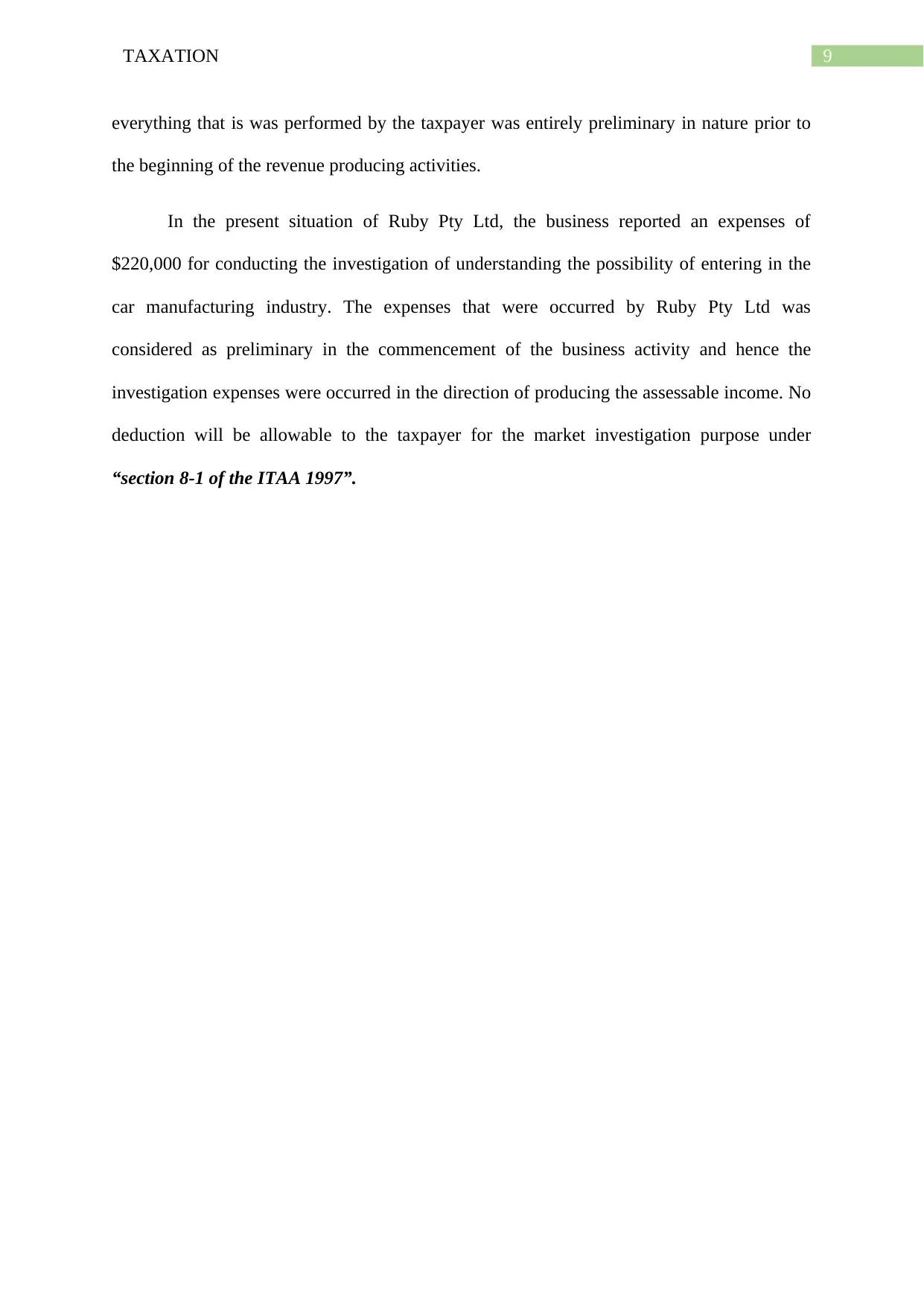
9TAXATION
everything that is was performed by the taxpayer was entirely preliminary in nature prior to
the beginning of the revenue producing activities.
In the present situation of Ruby Pty Ltd, the business reported an expenses of
$220,000 for conducting the investigation of understanding the possibility of entering in the
car manufacturing industry. The expenses that were occurred by Ruby Pty Ltd was
considered as preliminary in the commencement of the business activity and hence the
investigation expenses were occurred in the direction of producing the assessable income. No
deduction will be allowable to the taxpayer for the market investigation purpose under
“section 8-1 of the ITAA 1997”.
everything that is was performed by the taxpayer was entirely preliminary in nature prior to
the beginning of the revenue producing activities.
In the present situation of Ruby Pty Ltd, the business reported an expenses of
$220,000 for conducting the investigation of understanding the possibility of entering in the
car manufacturing industry. The expenses that were occurred by Ruby Pty Ltd was
considered as preliminary in the commencement of the business activity and hence the
investigation expenses were occurred in the direction of producing the assessable income. No
deduction will be allowable to the taxpayer for the market investigation purpose under
“section 8-1 of the ITAA 1997”.
Paraphrase This Document
Need a fresh take? Get an instant paraphrase of this document with our AI Paraphraser

10TAXATION
References:
Ball, R., Gerakos, J., Linnainmaa, J. T., & Nikolaev, V. (2016). Accruals, cash flows, and
operating profitability in the cross section of stock returns. Journal of Financial
Economics, 121(1), 28-45.
Barkoczy, S. (2014) Foundations of taxation law.
Barth, M. E., Clinch, G., & Israeli, D. (2016). What do accruals tell us about future cash
flows?. Review of Accounting Studies, 21(3), 768-807.
Bushman, R. M., Lerman, A., & Zhang, X. F. (2016). The changing landscape of accrual
accounting. Journal of Accounting Research, 54(1), 41-78.
Coleman, C., & Sadiq, K. (2013) Principles of taxation law.
Gordon, E. A., Henry, E., Jorgensen, B. N., & Linthicum, C. L. (2017). Flexibility in cash-
flow classification under IFRS: determinants and consequences. Review of
Accounting Studies, 22(2), 839-872.
Grange, J., Jover-Ledesma, G., & Maydew, G. (2014) principles of business taxation.
James, S. (2014) The economics of taxation.
Jover-Ledesma, G. (2014). Principles of business taxation 2015. [Place of publication not
identified]: Cch Incorporated.
Kenny, P. (2013). Australian tax 2013. Chatswood, N.S.W.: LexisNexis Butterworths.
Krever, R. (2013). Australian taxation law cases 2013. Pyrmont, N.S.W.: Thomson Reuters.
Morgan, A., Mortimer, C., & Pinto, D. (2013). A practical introduction to Australian taxation
law. North Ryde [N.S.W.]: CCH Australia.
References:
Ball, R., Gerakos, J., Linnainmaa, J. T., & Nikolaev, V. (2016). Accruals, cash flows, and
operating profitability in the cross section of stock returns. Journal of Financial
Economics, 121(1), 28-45.
Barkoczy, S. (2014) Foundations of taxation law.
Barth, M. E., Clinch, G., & Israeli, D. (2016). What do accruals tell us about future cash
flows?. Review of Accounting Studies, 21(3), 768-807.
Bushman, R. M., Lerman, A., & Zhang, X. F. (2016). The changing landscape of accrual
accounting. Journal of Accounting Research, 54(1), 41-78.
Coleman, C., & Sadiq, K. (2013) Principles of taxation law.
Gordon, E. A., Henry, E., Jorgensen, B. N., & Linthicum, C. L. (2017). Flexibility in cash-
flow classification under IFRS: determinants and consequences. Review of
Accounting Studies, 22(2), 839-872.
Grange, J., Jover-Ledesma, G., & Maydew, G. (2014) principles of business taxation.
James, S. (2014) The economics of taxation.
Jover-Ledesma, G. (2014). Principles of business taxation 2015. [Place of publication not
identified]: Cch Incorporated.
Kenny, P. (2013). Australian tax 2013. Chatswood, N.S.W.: LexisNexis Butterworths.
Krever, R. (2013). Australian taxation law cases 2013. Pyrmont, N.S.W.: Thomson Reuters.
Morgan, A., Mortimer, C., & Pinto, D. (2013). A practical introduction to Australian taxation
law. North Ryde [N.S.W.]: CCH Australia.

11TAXATION
Nallareddy, S., Sethuraman, M., & Venkatachalam, M. (2017). The changing landscape of
accrual accounting: Implications for operating cash flow predictability.
Pinto, D. (2013). State taxes. In Australian Taxation Law (pp. 1763-1762). CCH Australia
Limited.
Sadiq, K. (2014) Principles of taxation law.
Woellner, R., Barkoczy, S., Murphy, S., Evans, C., & Pinto, D. (2014) Australian taxation
law select.
Nallareddy, S., Sethuraman, M., & Venkatachalam, M. (2017). The changing landscape of
accrual accounting: Implications for operating cash flow predictability.
Pinto, D. (2013). State taxes. In Australian Taxation Law (pp. 1763-1762). CCH Australia
Limited.
Sadiq, K. (2014) Principles of taxation law.
Woellner, R., Barkoczy, S., Murphy, S., Evans, C., & Pinto, D. (2014) Australian taxation
law select.
⊘ This is a preview!⊘
Do you want full access?
Subscribe today to unlock all pages.

Trusted by 1+ million students worldwide
1 out of 12
Related Documents
Your All-in-One AI-Powered Toolkit for Academic Success.
+13062052269
info@desklib.com
Available 24*7 on WhatsApp / Email
![[object Object]](/_next/static/media/star-bottom.7253800d.svg)
Unlock your academic potential
Copyright © 2020–2025 A2Z Services. All Rights Reserved. Developed and managed by ZUCOL.


